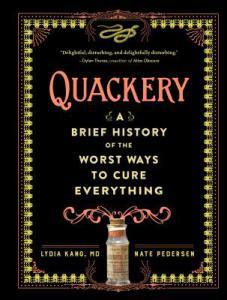
Book Cover Image: Quackery by Lydia Kang and Nate Pedersen
" data-orig-size="303,400" sizes="(max-width: 227px) 100vw, 227px" aperture="aperture" />BOTTOM LINE: Interesting information but trying too hard on the snark.
Genre: Nonfiction
Publication Date: 17 October 2017
Source: Publisher via NetGalley
Synopsis from the Publisher:
“What won’t we try in our quest for perfect health, beauty, and the fountain of youth?
Well, just imagine a time when doctors prescribed morphine for crying infants. When liquefied gold was touted as immortality in a glass. And when strychnine—yes, that strychnine, the one used in rat poison—was dosed like Viagra.
Looking back with fascination, horror, and not a little dash of dark, knowing humor, Quackery recounts the lively, at times unbelievable, history of medical misfires and malpractices. Ranging from the merely weird to the outright dangerous, here are dozens of outlandish, morbidly hilarious ‘treatments’—conceived by doctors and scientists, by spiritualists and snake oil salesmen (yes, they literally tried to sell snake oil)—that were predicated on a range of cluelessness, trial and error, and straight-up scams. With vintage illustrations, photographs, and advertisements throughout, Quackery seamlessly combines macabre humor with science and storytelling to reveal an important and disturbing side of the ever-evolving field of medicine.”
My Thoughts: Quackery follows a similar format as recent releases such as Get Well Soon or Wicked Bugs. Informative, witty, and irreverent, books like these have become a new way of learning. In Quackery, Lydia Kang and Nate Pedersen present all things medical from throughout the ages. Unfortunately, they fail at the witty and irreverent aspects of presenting information in this way, making for an uneven, somewhat uncomfortable read at times as they force their modern-day knowledge onto historical actions.
The information itself is as fascinating as it is horrifying to modern ears. Organized by type of medicine like elements, plants and soils, tools, animals, and mysterious powers, each section highlights the most popular historical methods of healing the sick. The authors present the justifications for use of each item, the item’s uses, and the item’s eventual downfall. They present a lot of information, and while some of it may be redundant for fans of medical history, the authors’ purpose to enlighten never wavers.
The problem with Quackery is that it tries too hard. The sarcastic asides and personal interjection of opinion that works so well for Sarah Vowell does not work for Ms. Kang and Mr. Pedersen. Their asides are just not funny. Their almost constant interruption of the narrative to insert their modern-day opinions is annoying rather than amusing. The biting wit that made similar books so entertaining is missing. One might even argue that such commentary is not appropriate. After all, while the so-called medicines might make us cringe today, they were used by people who honestly thought they were helpful. It makes me feel similar to watching someone mock the handicapped for acting a certain way even though they might not have control over their physical actions. There is no sympathy that our ancestors felt that blood-letting was a legitimate way to reduce a fever or that mercury soothed a child’s colic. Instead, they use modern medical knowledge to laugh and make fun of the past.
The other area of concern is that while the book is titled Quackery, there is not much focus on quackery itself. Rather, the authors have adopted the idea that all historical medicine is quackery because all historical medicine used harmful things to heal. In each chapter, there is brief mention of specific instances of quackery, like the snake oil salesman, but it is but a fraction of the total chapter and often explained in such a way that makes you realize there were legitimate reasons for selling such things. What is missing then is the real quackery – those doctors who used sugar pills for cures or those peddlers who sold sugar water as hair tonics.
Quackery taken as a history of medicinal practices is interesting. Ms. Kang and Mr. Pedersen take care to explain each item’s usage as well as the reasoning behind it. They add to this information with anecdotes, stories of patients, and pictures from medical textbooks or advertisements. Had they left things there, the book would be much stronger for it. Instead, the authors spend too much time adding their opinionated commentary, leaving readers with a bad impression. This is such a shame because there is so much to be learned about how people used to practice medicine and attempted to heal the sick and the reasons for choosing the tools they did. Sadly, I am now stuck wondering just what we are using now in medicine that will end up being something for which the authors would mock us fifty years from today.












Related Stories
- The surprisingly feminist Sleeping Beauties
- Don’t bother with Where the Light Falls
- Fierce Kingdom hits hard



